
Grinling Gibbons was an Anglo-Dutch sculptor and wood carver known for his work in England, including Windsor Castle and Hampton Court Palace, St Paul's Cathedral and other London churches, Petworth House and other country houses, Trinity College, Oxford, and Trinity College, Cambridge. Gibbons was born to English parents in Holland, where he was educated.

Sir Joseph Edgar Boehm, 1st Baronet, was an Austrian-born British medallist and sculptor, best known for the "Jubilee head" of Queen Victoria on coinage, and the statue of the Duke of Wellington at Hyde Park Corner. During his career Boehm maintained a large studio in London and produced a significant volume of public works and private commissions. A speciality of Boehm's was the portrait bust; there are many examples of these in the National Portrait Gallery. He was often commissioned by the Royal Family and members of the aristocracy to make sculptures for their parks and gardens. His works were many, and he exhibited 123 of them at the Royal Academy from 1862 to his death in 1890.

The Royal Canadian Mounted Police has, between 1969 and 2023, presented seven police service horses from the Musical Ride unit to two of Canada's monarchs: six horses to Queen Elizabeth II and one to King Charles III. PSH Burmese was used by Elizabeth for Trooping the Colour between 1969 and 1986. Charles has done the same with PSH Noble since 2023.

Windsor Castle is a royal residence at Windsor in the English county of Berkshire. It is strongly associated with the English and succeeding British royal family, and embodies almost a millennium of architectural history.

The Copper Horse is an 1831 equestrian statue of George III. The monumental bronze statue by Richard Westmacott stands on a stone plinth at Snow Hill in Windsor Great Park in the English county of Berkshire, at the southern end of the Long Walk, a tree-lined avenue which leads in a straight line about 2.65 mi (4.26 km) from the George IV Gateway at Windsor Castle. It became a Grade I listed building in 1972.

Hubert Le Sueur was a French sculptor with the contemporaneous reputation of having trained in Giambologna's Florentine workshop. He assisted Giambologna's foreman, Pietro Tacca, in Paris, in finishing and erecting the equestrian statue of Henri IV on the Pont Neuf. He moved to England and spent the most productive decades of his working career there, providing monuments, portraits and replicas of classical antiquities for the court of Charles I, where his main rival was Francesco Fanelli.

Tobias Rustat was a courtier to King Charles II and a benefactor of the University of Cambridge. He is remembered for creating the first fund for the purchase of books at the Cambridge University Library. He was an investor in, and Assistant of, the Royal African Company, an English mercantile company involved in the slave trade.

Ben Harms was a German-born traditional woodcarver working in England. Some of his work can be seen at The Tower of London, Windsor Castle, Kensington Palace, Hampton Court and alongside the work of Grinling Gibbons at Petworth House.
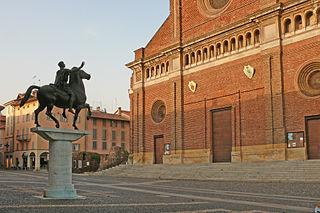
The Regisole was a bronze classical or Late Antique equestrian monument, highly influential during the Italian Renaissance but destroyed in 1796. It was originally erected at Ravenna, in what is now Italy, but was moved to Pavia in the Middle Ages, where it stood on a column before the cathedral, as an emblem of communal pride and Pavia's deep connection with imperial Rome.
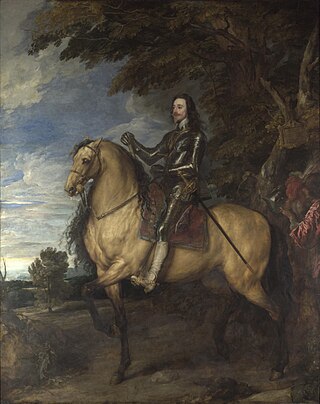
The Equestrian Portrait of Charles I is a large oil painting on canvas by Anthony van Dyck, showing Charles I on horseback. Charles I had become King of England, Scotland and Ireland in 1625 on the death of his father James I, and Van Dyck became Charles's Principal Painter in Ordinary in 1632.

Charles I with M. de St Antoine is an oil painting on canvas by the Flemish painter Anthony van Dyck, depicting Charles I on horseback, accompanied by his riding master, Pierre Antoine Bourdon, Seigneur de St Antoine.

St Michael and All Angels is a Grade I listed church on the estate of the Duke of Beaufort in the village of Great Badminton, Gloucestershire, England. Attached to the Duke of Beaufort's residence, Badminton House, it is an active Anglican parish church in the diocese of Gloucester. Although within the grounds of the Badminton Estate, the church is owned, and its upkeep met, by the Badminton's Parochial Church Council, rather than the Ducal estate. There is a smaller church of the same name in the neighbouring hamlet of Little Badminton.
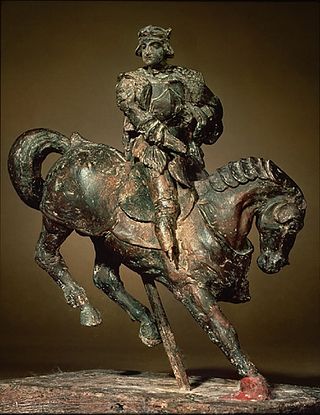
Horse and Rider is a beeswax sculpture depicting a rider on a horse. The history of the sculpture is unknown before the 20th century. The work has been attributed to Leonardo da Vinci by the Italian art historian Carlo Pedretti, though most historians have ignored or denied the attribution. A number of casts have been made, using a mold taken from the wax original.

The statue of James II is a bronze sculpture located in the front garden of the National Gallery in Trafalgar Square, London, United Kingdom. Probably inspired by French statues of the same period, it depicts James II of England as a Roman emperor, wearing Roman armour and a laurel wreath. It originally also depicted him holding a baton. It was produced by the workshop of Grinling Gibbons. The execution was most likely, according to contemporary accounts, the work of the sculptors Peter van Dievoet from Brussels and Laurens van der Meulen from Mechlin, rather than of Gibbons himself. The statue has been relocated several times since it was first erected in the grounds of the old Palace of Whitehall in 1686, only two years before James II was deposed.
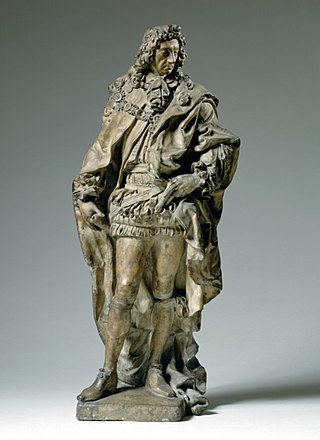
Artus Quellinus III, known in England as Arnold Quellin was a Flemish sculptor who after training in Antwerp was mainly active in London. Here he worked in partnership with the English sculptor Grinling Gibbons on some commissions. Some of the works created during their partnership cannot with certainty be attributed to Quellinus or Gibbons. The drop in quality of the large-scale figurative works in the workshop of Gibbons following the early death of Quellinus has been seen as evidence of this.

The Rearing Horse and Mounted Warrior or Budapest horse is a bronze sculpture attributed to Leonardo da Vinci. Depicting Francis I of France on a destrier horse, it is estimated to have been cast from a clay or wax model in the first half of the 16th century. The sculpture is in the permanent exhibit of the Budapest Museum of Fine Arts.

The statue of Charles II stands in the Figure, or Middle, Court of the Royal Hospital, Chelsea, London. The sculptor was Grinling Gibbons, and the statue was executed around 1680–1682. The king founded the Royal Hospital in 1682 as a home for retired army veterans. The statue is a Grade I listed structure.
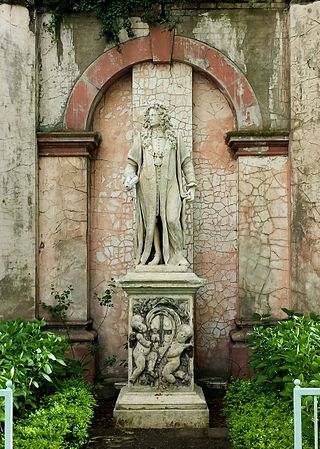
The statue of Robert Clayton stands at the entrance to the North Wing of St Thomas' Hospital, Lambeth, London. The sculptor was Grinling Gibbons, and the statue was executed around 1700–1714. Sir Robert was a banker, politician and Lord Mayor of London. As President of St Thomas', he was responsible for the complete rebuilding of the hospital, and associated church in the late 17th century. The statue was designated a Grade I listed structure in 1979.

An equestrian statue of Charles II trampling Cromwell stands near Newby Hall in North Yorkshire, England. It was previously sited at Gautby Hall in Lincolnshire, and was originally installed at the Stocks Market in the City of London. It is a Grade II listed building.



















